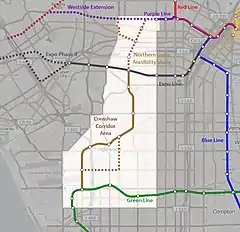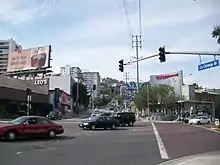Crenshaw Northern Extension Rail Project
The Crenshaw Northern Extension Rail Project is a planned Los Angeles Metro Rail light rail transit corridor extension connecting Expo/Crenshaw station to Hollywood/Highland station in Hollywood. The corridor is a north to south route along mostly densely populated areas of the Los Angeles Basin; it would be operated as part of the Crenshaw/LAX Line. The Los Angeles County Metropolitan Transportation Authority (Metro) is prioritizing the project along with pressure from the West Hollywood residents.[1][2] Construction is slated to start in 2041 and begin service by 2047 unless means to accelerate the project are found.[3]
| Overview | |||||||||||||||||||||||||||||||||||||||||||||||||||||||||||||||||||||||||||||||||||||||||||||||||||||||||||||||||||||||||||||||||||||||||||||||||||||||||||||||
|---|---|---|---|---|---|---|---|---|---|---|---|---|---|---|---|---|---|---|---|---|---|---|---|---|---|---|---|---|---|---|---|---|---|---|---|---|---|---|---|---|---|---|---|---|---|---|---|---|---|---|---|---|---|---|---|---|---|---|---|---|---|---|---|---|---|---|---|---|---|---|---|---|---|---|---|---|---|---|---|---|---|---|---|---|---|---|---|---|---|---|---|---|---|---|---|---|---|---|---|---|---|---|---|---|---|---|---|---|---|---|---|---|---|---|---|---|---|---|---|---|---|---|---|---|---|---|---|---|---|---|---|---|---|---|---|---|---|---|---|---|---|---|---|---|---|---|---|---|---|---|---|---|---|---|---|---|---|---|---|
| Status | Proposed | ||||||||||||||||||||||||||||||||||||||||||||||||||||||||||||||||||||||||||||||||||||||||||||||||||||||||||||||||||||||||||||||||||||||||||||||||||||||||||||||
| Locale | Crenshaw Hollywood | ||||||||||||||||||||||||||||||||||||||||||||||||||||||||||||||||||||||||||||||||||||||||||||||||||||||||||||||||||||||||||||||||||||||||||||||||||||||||||||||
| Service | |||||||||||||||||||||||||||||||||||||||||||||||||||||||||||||||||||||||||||||||||||||||||||||||||||||||||||||||||||||||||||||||||||||||||||||||||||||||||||||||
| Type | Light rail | ||||||||||||||||||||||||||||||||||||||||||||||||||||||||||||||||||||||||||||||||||||||||||||||||||||||||||||||||||||||||||||||||||||||||||||||||||||||||||||||
| System | Los Angeles Metro Rail | ||||||||||||||||||||||||||||||||||||||||||||||||||||||||||||||||||||||||||||||||||||||||||||||||||||||||||||||||||||||||||||||||||||||||||||||||||||||||||||||
| Operator(s) | |||||||||||||||||||||||||||||||||||||||||||||||||||||||||||||||||||||||||||||||||||||||||||||||||||||||||||||||||||||||||||||||||||||||||||||||||||||||||||||||
| History | |||||||||||||||||||||||||||||||||||||||||||||||||||||||||||||||||||||||||||||||||||||||||||||||||||||||||||||||||||||||||||||||||||||||||||||||||||||||||||||||
| Opened | 2047 (expected) | ||||||||||||||||||||||||||||||||||||||||||||||||||||||||||||||||||||||||||||||||||||||||||||||||||||||||||||||||||||||||||||||||||||||||||||||||||||||||||||||
| Technical | |||||||||||||||||||||||||||||||||||||||||||||||||||||||||||||||||||||||||||||||||||||||||||||||||||||||||||||||||||||||||||||||||||||||||||||||||||||||||||||||
| Track gauge | 4 ft 8 1⁄2 in (1,435 mm) | ||||||||||||||||||||||||||||||||||||||||||||||||||||||||||||||||||||||||||||||||||||||||||||||||||||||||||||||||||||||||||||||||||||||||||||||||||||||||||||||
| Electrification | 750 V DC overhead line | ||||||||||||||||||||||||||||||||||||||||||||||||||||||||||||||||||||||||||||||||||||||||||||||||||||||||||||||||||||||||||||||||||||||||||||||||||||||||||||||
| |||||||||||||||||||||||||||||||||||||||||||||||||||||||||||||||||||||||||||||||||||||||||||||||||||||||||||||||||||||||||||||||||||||||||||||||||||||||||||||||
Overview
The Los Angeles County Metropolitan Transportation Authority (Metro) has $2.33 billion from Measure M. The Crenshaw/LAX Line is a light rail line that is currently under construction between the Green Line and the E Line. With connection to LAX. A northern extension could possibly connect with regional job centers and tourist destinations. Cedars-Sinai Medical Center, Beverly Center, The Grove, Farmers Market shopping area and LACMA. The West Hollywood areas are also in the projected routes, Melrose and the sunset strip within walking distance.
The original plans for the Crenshaw Corridor project connected Wilshire Blvd to LAX. However, during environmental review, Metro determined that if LRT were selected as the preferred mode, the cost for the entire route would exceed the project budget. In December 2009, the Metro Board selected LRT as the preferred mode; as a result, the part of the corridor north of Exposition Boulevard was deferred until funds become available. This segment can be considered a "Phase 2" extension of the original line.
Any Phase 2 extension would be expected to connect to the D Line, the first phase of which is currently under construction as part of the Purple Line Extension project.

In May 2009, Metro released a report on the feasibility of an extension north to Wilshire Boulevard.[4] It first screened two routes—one to Wilshire/La Brea, and another to Wilshire/Crenshaw. Through this screening, staff concluded that Wilshire/La Brea station would be more cost-effective and more compatible with land uses and plans along its route. Specifically, the report cited the following advantages of the La Brea route over the Crenshaw route:
- Greater residential and job density,
- Supportive land-uses for a high capacity subway,
- Stronger regional potential to link this corridor northward towards Hollywood in the future,
- Strong community support in the Hancock Park area and
- Fewer geotechnical soil impacts compared to the Hydrogen sulfide soil along Crenshaw Blvd north of Pico Boulevard.
In October 2010, the Metro Board voted to eliminate the Wilshire/Crenshaw station from the D Line Subway Extension project, for similar reasons.[5]
The 3.5-mile Wilshire/La Brea route heads north on Crenshaw to Venice, west on Venice to San Vicente, continuing northwest on San Vicente to La Brea, and then north on La Brea to Wilshire. It has three possible stations: Crenshaw/Adams (optional), Pico/San Vicente, and Wilshire/La Brea.
The feasibility report also allowed for two possible branches/extensions along La Brea Ave, Fairfax Ave, La Cienega Blvd or San Vicente Blvd heading north of Wilshire into West Hollywood and/or Hollywood.
In November 2010, Metro staff produced an initial review of the feasibility of studying a new transit corridor to connect the Crenshaw Corridor to West Hollywood and/or Hollywood.[6]
In May 2014, the West Hollywood City Council considered a proposal by Council members John Heilman and Jeffrey Prang to engage a lobbyist to promote the need for Metro rail services in West Hollywood. The Heilman/Prang proposal notes that "former Los Angeles Mayor Antonio Villaraigosa assured West Hollywood representatives that West Hollywood would be 'next in line'."[7] In 2015, the West Hollywood City Council launched the West Hollywood Advocates for Metro Rail (WHAM) as part of a campaign to win grassroots support for a Metro rail extension into the city.[8]
In September 2016, in a letter to West Hollywood City Council member Lindsey Horvath, Metro CEO Phil Washington outlined several steps Metro is taking to make the Crenshaw/LAX northern extension "shovel ready" should county voters approve Measure M, a countywide ballot measure adding new transit projects and expediting others previously approved under Measure R.[9]
Connection to Phase 1
The final design of "Phase 1" (the original project line south of Exposition Blvd to LAX) would determine how the Phase 2 project could or would connect to Phase 1. The original locally preferred alternative (LPA) for the Crenshaw/LAX Line from the draft environmental impact study (Draft EIS/EIR) specified an at-grade station at the Phase 1 Expo/Crenshaw terminus, with the Leimert Park tunnel ending several blocks south of that, near 39th Street. If Phase 1 was built per the LPA, then Phase 2 would require the building of a new tunnel with a connection near 39th Street. This would require the north end of the Leimert Park tunnel to be outfitted with knockout panels to allow for the possible future extension north.[10]
Metro also studied "Design Option 6" for Phase 1, which would extend the Leimert Park tunnel north to the line's northern terminus at Exposition, with an underground station at Crenshaw/Exposition. This design option was selected so that Phase 2 can connect to Phase 1 directly at the Crenshaw/Exposition station's tunnels. This design option increased the cost of the original Phase 1 project by $236 million.[11]
Proposed routes
In July 2018, Metro released its initial set of rail concepts and rail alternatives for the corridor.[1] Conducted by AECOM.
Initial alternatives analysis
The July 2018 concepts released by Metro included five alternative plans for study. These included different alignments, but the same mode, light rail as the Crenshaw corridor phase one is currently under construction as light rail. Of the original five, a "Vermont Route" option was dropped in October 2019 due to public comments. A hybrid San Vicente option was added at the same time. On August 17th, 2020, Metro recommended three final alignments for environmental analysis and advanced conceptual engineering.[12][13] The current three alternatives considered are all south to north routes:
| DEIR Alternative[14] | Description | New trips (daily) |
Estimated cost (billions) |
|---|---|---|---|
| 1: San Vicente Hybrid Alternative[1] | Continuing north underground from Expo/Crenshaw station, veer northwest on San Vicente boulevard and rises to aerial and at-grade along the center median at various points. Heads underground north on Fairfax Ave. for one mile. Turns west on Beverly Boulevard at the Grove Market for one mile, heads north on San Vicente Blvd at Beverly Center Mall for another mile. Then east on Santa Monica Boulevard thru West Hollywood to terminate at Hollywood/Highland station or a Hollywood Bowl station in Hollywood. This route was added late 2019 due to public comments of wanting direct access to local work and tourist destinations. | 90,000 | 5.5 |
| 2: Fairfax Alternative[1] | Continuing north underground from Crenshaw/Expo station, veer northwest on San Vicente boulevard and rises to aerial and at-grade along the center median at various points. Heads north underground at Fairfax Avenue thru Central Los Angeles to West Hollywood where it turns East on Santa Monica Blvd towards Hollywood/Highland or Hollywood Bowl Station in Hollywood. | 88,700 | 4.7 |
| 3: La Brea Alternative[1] | Continuing north underground from Crenshaw/Expo station, veer northwest on San Vicente boulevard and rises to aerial and at-grade along the center median at various points. Heads north underground at La Brea Avenue thru Central Los Angeles to West Hollywood where it turns East on Santa Monica Blvd towards Hollywood/Highland or Hollywood Bowl Station in Hollywood. | 87,200 | 3.0 |
The following table shows all potential metro stations, and the alternatives for which they apply:


| Station Options[1] (North to South) | Alt 1: H-SV | Alt 2: FF | Alt 3: LB | Connecting rail services[15] |
|
|---|---|---|---|---|---|
| Hollywood Bowl | × | × | × | Direct access to Hollywood Bowl. Added due to public comments.[16] | |
| Hollywood/Highland (already built) | × | × | × | Hollywood Boulevard Entertainment District, Dolby Theater. Connection to the B Line to DTLA or the San Fernando Valley. | |
| La Brea/Santa Monica | × | × | × | West Hollywood Gateway shopping, The Lot (OWN), Jim Henson Company Lot, Desilu Studios & Sunset Las Palmas Studios nearby. | |
| Fairfax/Santa Monica | × | × | - | West Hollywood | |
| La Cienega/Santa Monica | × | - | - | Sunset Strip .5 mile northwest, West Hollywood | |
| San Vicente/Santa Monica | × | - | - | SBE Entertainment Group, The Troubadour, Robertson Boulevard | |
| San Vicente/La Cienega/Beverly | × | - | - | Pacific Design Center, Cedars-Sinai Medical Center, Beverly Center Mall, Melrose Avenue Shopping District | |
| Fairfax/3rd St. | × | × | - | The Grove at Farmers Market, Television City, Los Angeles Museum of the Holocaust | |
| La Brea/Beverly | - | - | × | High density neighborhood | |
| Wilshire/Fairfax (under construction) | × | × | - | LACMA, Museum Row, High density neighborhood and retail | |
| Wilshire/La Brea (under construction) | - | - | × | High density neighborhood and retail, Hancock Park | |
| San Vicente/Fairfax | × | × | - | Little Ethiopia | |
| San Vicente/Venice/Pico | × | × | × | Re-construct the former PE Pico/Rimpau "Vinyard Junction station; current Pico-Rimpau Bus Transfer Station at Mid-town Crossing Center | |
| Crenshaw/Adams | × | × | × | Mid-Density neighborhood | |
| Expo/Crenshaw (under construction) * | × | × | × | Continues south to LAX, the C Line and South Bay beach cities | |
| Distance: Miles (Kilometers): | 9.9 (15.9 km) | 8.1 (13 km) | 6.5 (10.4 km) | ||
- Expo/Crenshaw station is currently under construction and not a part of phase two study as part of Crenshaw/LAX Line phase one.
Advocacy
The city council approved a resolution in May 2018, to expedite its own environmental study to speed up the approval process with Metro. Metro's 2018 budget included $500,000 to begin the draft environmental study for the extension project. Local residents created the West Hollywood Advocates for Metro Rail to advocate a new LRT or HRT thru Santa Monica boulevard.[17] Los Angeles City Council president Herb Wesson wrote an op-ed piece in the LA Times advocating acceleration of the project.[18] Los Angeles local congressional representative Adam Schiff also voiced his support for acceleration in a letter to metro CEO in March 2019.[19]
References
- "Feasibility study looks at possible routes for Crenshaw North Extension". thesource.metro.net. 22 July 2018.
- "Rail concepts released for Sepulveda Transit Corridor project". 8 June 2018.
- "Five Options Under Consideration for the Crenshaw/LAX Line's Northern Extension". 23 July 2018.
- "Crenshaw Transit Corridor Project Final Feasibility Study - Wilshire/La Brea Transit Extension" (PDF). Metro (LACMTA). May 2009. Retrieved 2014-01-23.
- "AGENDA Regular Board of Directors Meeting" (PDF). Metro (LACMTA). October 28, 2010. pp. 10–12. Retrieved 2014-01-23.
- "Measure R Project Delivery Committee Hollywood/West Hollywood Transit Corridor Connection To Crenshaw/LAX Transit Corridor Initial Review" (PDF). Metro (LACMTA). November 18, 2010. Retrieved 2014-01-23.
- "WeHo to Consider Stepping Up Efforts to Lure a Metro Line Stop - WEHOville". 2 May 2014.
- "How West Hollywood Is Fighting for Its Own Subway Los Angeles Magazine". 23 February 2016.
- "Metro Moves Up Date for Possible Northern Extension of Crenshaw/LAX Line - WEHOville". 17 September 2016.
- "Crenshaw-Prairie Transit Corridor Project Status Report" (PDF). Metro (LACMTA). March 19, 2008. Retrieved 2008-07-21.
- "Crenshaw/LAX Transit Corridor Project Final Environmental Impact Report/Final Environmental Impact Statement Executive Summary" (PDF). Metro (LACMTA). August 2011. p. ES-26. Retrieved 2014-01-21.
- https://thesource.metro.net/2020/08/17/three-routes-recommended-for-further-study-on-crenshaw-northern-extension-project/
- https://urbanize.la/post/west-hollywood-pushes-accelerate-crenshaw-line-extension
- "Rail concepts released for Sepulveda Transit Corridor project". 8 June 2018.
- "Bus and Rail System Map" (PDF). Los Angeles County Metropolitan Transportation Authority. Retrieved 2018-12-03.
- https://urbanize.la/post/west-hollywood-pushes-accelerate-crenshaw-line-extension
- "WHAM – West Hollywood Advocates for Metro Rail". www.whamrail.com.
- https://www.latimes.com/opinion/story/2019-09-27/cresnshaw-line-transit-south-central-los-angeles
- https://www.wehoville.com/2019/03/20/adam-schiff-nudges-metro-to-clarify-its-schedule-for-the-crenshaw-line-extension/
